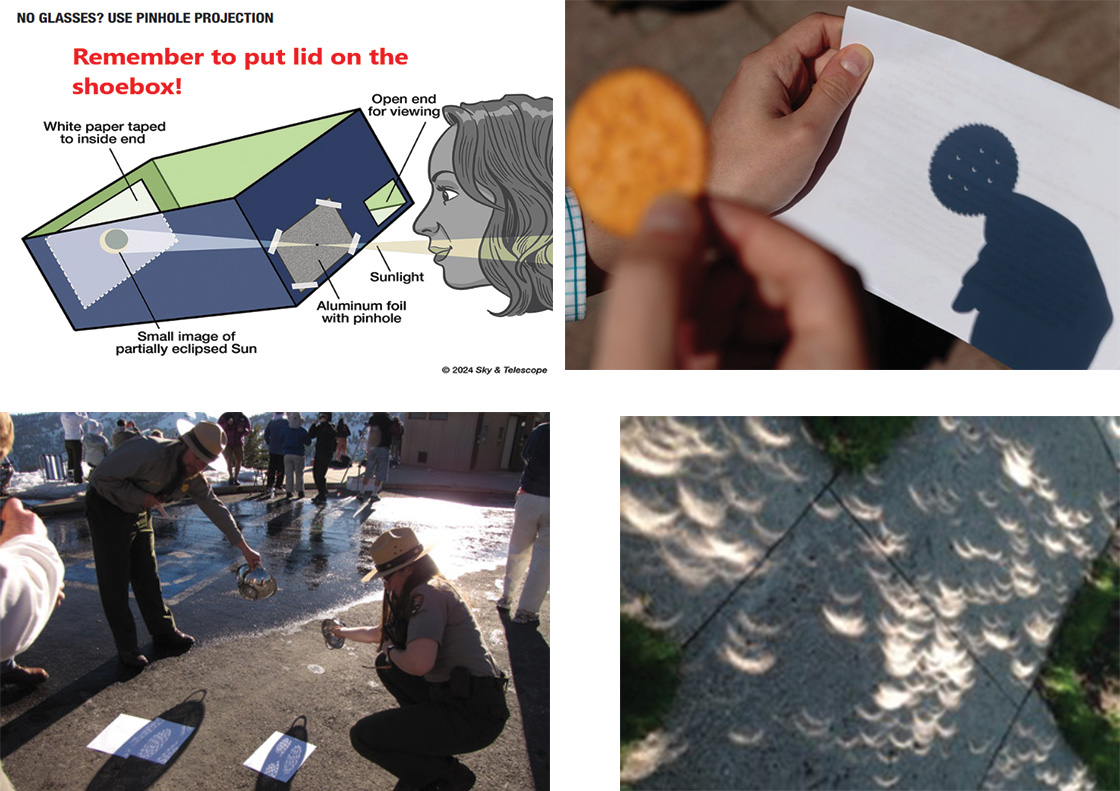THE APRIL 8 SOLAR ECLIPSE PART III: See the Magic Happen
As I write this, it is now the end of March and we are getting very close to Eclipse Day, Monday April 8th. In the two previous editions of this blog, I discussed “Why the Magic Happens” and “Where the Magic Happens.” For this last eclipse posting, I am going to give some suggestions on how you can safely see this rare celestial event.
As mentioned previously, the eclipse experience is vastly more impressive if you travel into the path of totality. However, during the partial stages, the rules are still the same whether you are in the path or not- you must not directly view the Sun when any part of the bright surface is visible. In order to safely watch, you must either use a safe solar filter in front of your eyes or view the Sun indirectly.
The easiest way to do indirect viewing is by pinhole projection. This means that anything with a tiny hole can project a tiny solar image onto your hand, a white card, or the ground. Some examples are shown below- my Mom made a shoebox much like the one shown for me and my siblings to view partial eclipses during the 1960s and 1970s. The smaller the pinhole, the brighter and sharper but also tinier the resulting solar image will be. This method works perfectly as long as the day is pretty clear and the Sun is shining brightly. You could also try to create images by spreading your fingers on your hand.

A shoebox, cracker, colander from your kitchen, or leaves on trees can all project tiny images of the partially eclipsed Sun. Courtesy Sky & Telescope magazine and NPS.
It is also possibly to view directly, if you have a safe material between your eyes and the bright Sun. Even a small amount of bright sunlight can damage your eyes. Some people use #14 welder’s glasses (no other type), but the most common method would be eclipse glasses. These are made up of a mylar or polymer material that blocks all but the tiniest fraction of the Sun’s light from coming through. There are reports of counterfeit glasses being sold- make sure that your glasses have the international standard of “ISO 12312-2” printed on them. In addition, check your glasses. Hold them up to a bright light and make sure that there are no scratches, dents or pinholes on the lenses that let any light through. You should see nothing through the glasses unless you are looking at the bright Sun or possibly an extremely bright light. If you see any defects in the glasses, throw them away! You can also might able to purchase this material in sheets and fashiion filters for your binoculars, cameras, or small telescopes. MAKE SURE THAT THESE ARE SECURELY ATTACHED TO THE FRONT LENS OF THESE DEVICES, so that they don’t fall off in the wind or while you are moving them. Binoculars, cameras and telescopes magnify and concentrate the Sun’s light, so putting eclipse glasses on is not enough protection- put the material IN FRONT OF THE LENS.
What if you are in the path of totality? Once the last bit of bright sunlight fades out and the total phase of the eclipse begins, YOU WILL SEE NOTHING WITH ECLIPSE GLASSES OR PINHOLE VIEWERS, as there no longer will be any dangerous sunlight still shining. It will be perfectly safe to look at the totally eclipsed Sun directly during totality, which will last at most four minutes if you are at the centerline of the path. However, you must put your eclipse glasses back on or resume using your pinhole viewers as soon as the bright Sun starts to return. To be honest, once totality is over, the air has been let out of the balloon and people tend to pay much less attention to the concluding partial stages, which last about 75 minutes and are a replay of the beginning of the eclipse, in reverse order. Remember that if you are not in the path of totality, eclipse glasses must be used at all times!
If you are able to get any sucessful pictures of the eclipse, send them to me at richard_fefferman@nps.gov and I will try to include them in a future edition of this blog. Let’s cross our fingers and hope for clear skies on April 8th!!
Would you like to learn even more about the eclipse? Due to the overwhelming popularity of our previous programs, Gateway Arch National Park will offer more Eclipse Education programs on Saturday & Sunday, April 6th and 7th. At 11 am on both dates, children 4-13 can work with our Sky Ranger and earn the special Junor Ranger Eclipse Explorer badge. Supplies are limited and the badges and booklets will only be available at the time of these programs. At 1 pm on both dates, a program for the general public, “The Great American Eclipse of 2024” will be presented. All of these programs will be held in our Education Classroom, and SPACE IS LIMITED. Call 314-655-1704 or e-mail richard_fefferman@nps.gov in order to reserve your place.
